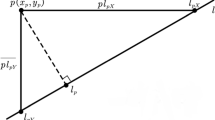Abstract
In this article, we study a variant of the geometric minimum spanning tree (MST) problem. Given a set \(\mathcal{S}\) of n disjoint line segments in  , we need to find a tree spanning one endpoint from each of the segments in \(\mathcal{S}\). Note that, we have \(2^n\) possible choices of such a set of endpoints, each being referred as an instance. Thus, our objective is to choose one among those instances such that the sum of the lengths of all the edges of the tree spanning the points of that instance is minimum. We show that finding such a spanning tree is NP-complete in general, and propose a \(O(\log ^2 n)\)-factor approximation algorithm for the same.
, we need to find a tree spanning one endpoint from each of the segments in \(\mathcal{S}\). Note that, we have \(2^n\) possible choices of such a set of endpoints, each being referred as an instance. Thus, our objective is to choose one among those instances such that the sum of the lengths of all the edges of the tree spanning the points of that instance is minimum. We show that finding such a spanning tree is NP-complete in general, and propose a \(O(\log ^2 n)\)-factor approximation algorithm for the same.
Access this chapter
Tax calculation will be finalised at checkout
Purchases are for personal use only
Similar content being viewed by others
Notes
- 1.
Its vertices are the 2n segment endpoints; two vertices a and b are connected by an edge, if and only if the corresponding line segment ab is either in \(\mathcal{S}\) or if the open segment ab does not intersect any (closed) segment from \(\mathcal{S}\).
- 2.
A variable gadget may be connected with multiple literal gadgets.
- 3.
This segment corresponds to the binary relation or.
- 4.
Only one endpoint of a segment can participate in the tree.
- 5.
The maximum possible distance between a pair of points.
- 6.
In each iteration at least half of the segments are deleted from \(\mathcal{S}\).
References
Agarwal, P.K., Edelsbrunner, H., Schwarzkopf, O., Welzl, E.: Euclidean minimum spanning trees and bichromatic closest pairs. Discret. Comput. Geom. 6(1), 407–422 (1991)
Arora, S.: Polynomial time approximation schemes for euclidean traveling salesman and other geometric problems. J. ACM (JACM) 45(5), 753–782 (1998)
Awerbuch, B., Azar, Y., Blum, A., Vempala, S.: New approximation guarantees for minimum-weight \(k\)-trees and prize-collecting salesmen. SIAM J. Comput. 28(1), 254–262 (1998)
Blum, A., Chalasani, P., Vempala, S.: A constant-factor approximation for the \(k\)-MST problem in the plane. In: Proceedings of the Twenty-Seventh Annual ACM Symposium on Theory of Computing, pp. 294–302. ACM (1995)
Borgelt, M.G., Van Kreveld, M., Löffler, M., Luo, J., Merrick, D., Silveira, R.I., Vahedi, M.: Planar bichromatic minimum spanning trees. J. Discret. Algorithms 7(4), 469–478 (2009)
Bose, P., Houle, M.E., Toussaint, G.T.: Every set of disjoint line segments admits a binary tree. Discret. Comput. Geom. 26(3), 387–410 (2001)
Bose, P., Smid, M.: On plane geometric spanners: a survey and open problems. Comput. Geom. 46(7), 818–830 (2013)
Bose, P., Toussaint, G.: Growing a tree from its branches. J. Algorithms 19(1), 86–103 (1995)
Chlebík, M., Chlebíková, J.: The steiner tree problem on graphs: inapproximability results. Theoret. Comput. Sci. 406(3), 207–214 (2008)
Daescu, O., Ju, W., Luo, J.: NP-completeness of spreading colored points. In: Wu, W., Daescu, O. (eds.) COCOA 2010. LNCS, vol. 6508, pp. 41–50. Springer, Heidelberg (2010). https://doi.org/10.1007/978-3-642-17458-2_5
Eppstein, D.: Spanning trees and spanners (1996). https://www2.cs.duke.edu/courses/spring07/cps296.2/papers/SpanningTrees.pdf
Eppstein, D.: Faster geometric \(k\)-point MST approximation. Comput. Geom. 8(5), 231–240 (1997)
Garey, M.R., Johnson, D.S.: Computers and Intractability, vol. 29. W. H. Freeman, New York (2002)
Garg, N.: Saving an epsilon: a 2-approximation for the \(k\)-MST problem in graphs. In: Proceedings of the Thirty-Seventh Annual ACM Symposium on Theory of Computing, pp. 396–402. ACM (2005)
Garg, N., Hochbaum, D.S.: An \({O}(\log k)\) approximation algorithm for the \(k\) minimum spanning tree problem in the plane. In: Proceedings of the Twenty-Sixth Annual ACM Symposium on Theory of Computing, pp. 432–438. ACM (1994)
Hoffmann, M., Speckmann, B., Tóth, C.D.: Pointed binary encompassing trees: simple and optimal. Comput. Geom. 43(1), 35–41 (2010)
Hoffmann, M., Tóth, C.D.: Segment endpoint visibility graphs are hamiltonian. Comput. Geom. 26(1), 47–68 (2003)
Mitchell, J.S.: Guillotine subdivisions approximate polygonal subdivisions: a simple polynomial-time approximation scheme for geometric tsp, \(k\)-MST, and related problems. SIAM J. Comput. 28(4), 1298–1309 (1999)
Rajagopalan, S., Vazirani, V.: Logarithmic approximation of minimum weight \(k\) trees. Unpublished Manuscript (1995)
Rappaport, D., Imai, H., Toussaint, G.T.: Computing simple circuits from a set of line segments. Discret. Comput. Geom. 5(1), 289–304 (1990)
Ravi, R., Sundaram, R., Marathe, M.V., Rosenkrantz, D.J., Ravi, S.S.: Spanning trees - short or small. SIAM J. Discret. Math. 9(2), 178–200 (1996)
Smid, M.: The well-separated pair decomposition and its applications (2016). https://people.scs.carleton.ca/~michiel/aa-handbook.pdf
Zelikovsky, A., Lozevanu, D.: Minimal and bounded trees. In: Tezele Cong. XVIII Acad. Romano-Americane, Kishniev, pp. 25–26 (1993)
Author information
Authors and Affiliations
Corresponding author
Editor information
Editors and Affiliations
Rights and permissions
Copyright information
© 2018 Springer International Publishing AG, part of Springer Nature
About this paper
Cite this paper
Dey, S., Jallu, R.K., Nandy, S.C. (2018). Minimum Spanning Tree of Line Segments. In: Wang, L., Zhu, D. (eds) Computing and Combinatorics. COCOON 2018. Lecture Notes in Computer Science(), vol 10976. Springer, Cham. https://doi.org/10.1007/978-3-319-94776-1_44
Download citation
DOI: https://doi.org/10.1007/978-3-319-94776-1_44
Published:
Publisher Name: Springer, Cham
Print ISBN: 978-3-319-94775-4
Online ISBN: 978-3-319-94776-1
eBook Packages: Computer ScienceComputer Science (R0)




